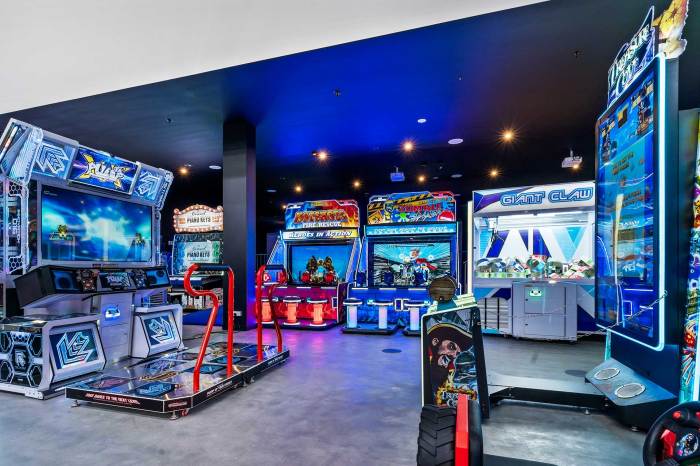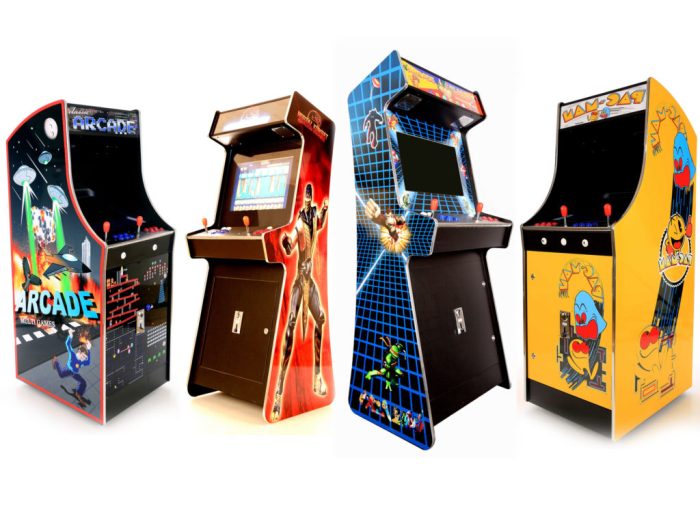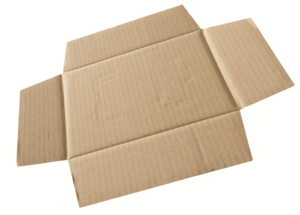
Arcade machine repair is a fascinating blend of nostalgia and technical skill, inviting enthusiasts to dive deep into the world of retro gaming. From diagnosing electrical issues to replacing worn-out speakers, understanding the inner workings of these machines can bring old games back to life and enhance the gaming experience for many.
This guide covers essential components of arcade machines, troubleshooting common problems, and maintenance techniques, ensuring both the seasoned technician and the curious gamer can appreciate the art of arcade repair.
Arcade Machine Repair Basics
Arcade machines are a nostalgic and entertaining part of gaming culture, but like any electronic devices, they can experience issues over time. Understanding the basics of arcade machine repair is essential for enthusiasts and technicians alike. This guide covers common components, diagnosing electrical issues, and essential tools for repairing these vintage machines.
Common Components of Arcade Machines
Arcade machines consist of several key components, each playing a vital role in their operation. Understanding these parts helps in identifying and diagnosing issues effectively. The main components include:
- Monitor: Displays the game visuals. Common types include CRT and LCD screens.
- Control Panel: Contains the joystick and buttons used for gameplay.
- Main PCB (Printed Circuit Board): The brain of the arcade machine, it processes the game’s software and controls the hardware components.
- Power Supply: Converts AC power to the required DC voltages for the components.
- Speakers: Output the game’s sound effects and music.
- Coin Mechanism: Accepts coins for game play, ensuring the machine functions as intended.
Diagnosing Electrical Issues in Arcade Machines
Identifying electrical issues in arcade machines requires a systematic approach. Here are the steps to effectively diagnose such problems:
1. Visual Inspection
Start with a thorough visual examination of all components for signs of damage or wear, such as burnt connectors or frayed wires.
2. Check Power Supply
Verify that the power supply is functioning correctly. Measure output voltages using a multimeter to ensure they match the specifications required by the arcade machine.
3. Test the Monitor
If the screen is blank or distorted, check connections and power. Testing with a known working monitor can help determine if the issue lies with the monitor or the PCB.
4. Inspect the PCB
Look for bulging capacitors or burnt traces. Reseating connectors and checking for continuity can also help identify faults.
5. Examine Control Inputs
Test all buttons and joysticks to ensure they are functioning correctly. A faulty control panel can prevent gameplay even if the rest of the machine is operational.
Effective diagnosis often requires patience and a methodical approach to isolate the problem.
Essential Tools for Arcade Machine Repair
Having the right tools is crucial for successful arcade machine repair. Below is a list of essential tools that should be in any technician’s toolkit:
- Multimeter: For measuring voltage, current, and resistance to diagnose electrical issues.
- Soldering Iron: Necessary for repairing or replacing electronic components on circuit boards.
- Wire Strippers: Used for preparing and connecting wires securely.
- Socket Set: A set of various sized sockets for removing and securing components.
- Phillips and Flathead Screwdrivers: Essential for opening cabinets and securing parts.
Troubleshooting Common Problems
Arcade machines, while nostalgic and fun, can sometimes present issues that hinder gameplay. Identifying these common problems and their causes is essential for effective repair. This section will cover frequent issues found in arcade machines, as well as methods to address display malfunctions and sound issues.
Frequent Issues in Arcade Machines
Understanding the common problems that arise in arcade machines helps in diagnosing and fixing them efficiently. Here are some of the most prevalent issues and their possible causes:
- Display Issues: Flickering screens, distorted images, or completely black screens can often result from loose connections, faulty power supplies, or damaged display hardware.
- Sound Problems: No sound or distorted audio can stem from faulty speakers, loose wiring, or issues with the soundboard.
- Input Malfunctions: Unresponsive controls can be caused by worn-out buttons or joysticks, bad connections, or issues with the circuit board.
- Overheating: Machines may shut down unexpectedly if they overheat, due to dust accumulation, inadequate ventilation, or failing fans.
Fixing Display Malfunctions
Display issues are among the most common problems faced in arcade machines. Proper diagnosis is crucial for effective repairs. These steps can help fix display malfunctions:Start by checking all the connections to the monitor and ensure that they are secure. Loose wires can often lead to display problems.
-
Inspect the power supply
If the power supply is faulty, it may not provide adequate voltage to the monitor. Use a multimeter to check the output.
- If the display is still malfunctioning, consider testing the monitor with another working arcade board to rule out issues with the game itself.
- In cases where the display is damaged, replacement may be needed. Look for a compatible monitor and follow the manufacturer’s instructions for installation.
After identifying the issue, remember the following quote:
“A clear display is essential for enjoyable gameplay.”
Addressing Sound Issues in Arcade Machines
Sound problems can significantly diminish the arcade experience. Understanding how to troubleshoot and resolve these issues is vital. Here’s how to approach sound malfunctions:
- Start by checking the volume settings on the arcade machine. Sometimes, the volume is simply turned down or muted.
- Inspect speakers for any visible damage. If the speakers are blown, replacing them is necessary. Choose speakers that match the original specifications for optimal performance.
- Check all wiring connections leading to the speakers and soundboard. Loose or frayed wires can interrupt sound output.
- If the issue persists, test the soundboard by replacing it with a known working unit to isolate the problem.
When replacing speakers, consider this important note:
“Using quality replacement parts ensures better sound performance and longevity.”
Maintenance and Care

Regular maintenance and care are essential for prolonging the life of arcade machines. These vintage gems not only provide entertainment but can also be valuable collector’s items. Proper upkeep ensures they remain operational and visually appealing for years to come.Preventative maintenance techniques can significantly reduce the likelihood of breakdowns and costly repairs. By implementing a schedule for regular inspections and upkeep, arcade enthusiasts can enjoy uninterrupted gameplay.
Routine care also enhances the aesthetic appeal of machines, keeping them looking pristine.
Preventative Maintenance Techniques
Implementing preventative maintenance techniques can greatly extend the lifespan of arcade machines. The following practices are vital for ensuring optimal performance:
- Regular Dusting: Dust accumulation can lead to overheating and internal damage. Use a soft, dry cloth to wipe down the exterior and controls weekly.
- Checking Connections: Loose or corroded connections can cause malfunction. Inspect wiring and connectors monthly, tightening or replacing as necessary.
- Monitoring Temperature: Extreme temperatures can affect performance. Keep machines in a controlled environment, ideally between 68°F and 72°F.
- Updating Software: Many arcade machines have software that can be updated. Check for updates quarterly to enhance functionality and security.
- Inspecting the Monitor: Regularly check for screen flickering or discoloration. Address issues promptly to prevent further damage.
Regular Maintenance Schedule
Establishing a structured maintenance schedule helps ensure that all necessary tasks are completed consistently. The following schedule can guide arcade owners in their upkeep efforts:
| Frequency | Task | Description |
|---|---|---|
| Weekly | Dusting and Exterior Cleaning | Wipe down surfaces with a microfiber cloth to remove dust and fingerprints. |
| Monthly | Connection Checks | Inspect and secure all wiring and connections to prevent electrical issues. |
| Quarterly | Monitor Calibration | Calibrate the monitor settings to ensure clear and vibrant display quality. |
| Annually | Full Inspection | Conduct a thorough inspection of all components, replacing parts as needed. |
Cleaning and Preserving Exterior
Maintaining the exterior of arcade machines is crucial for preserving their aesthetic appeal and ensuring longevity. Here’s how to properly clean and care for these machines:The first step in cleaning is to gather appropriate supplies, including microfiber cloths, gentle cleaning solutions, and a soft brush for hard-to-reach areas. Regular cleaning not only enhances the machine’s appearance but also prevents wear and tear caused by dirt and grime accumulation.
- Surface Cleaning: Use a damp microfiber cloth with a mild cleaning solution to wipe down the control panel, side art, and glass. Avoid harsh chemicals that could damage the finish.
- Glass Panel Care: For glass surfaces, a glass cleaner can be used. Apply it to a cloth rather than directly to the glass to prevent streaks.
- Protective Coatings: Consider applying a protective wax or sealant every few months to enhance shine and provide a barrier against dust and fingerprints.
- Artwork Preservation: If the machine has decals or artwork, avoid using abrasive materials that could scratch or fade the design. Gently clean with a damp cloth.
Final Conclusion

In conclusion, mastering arcade machine repair not only preserves the joy of classic gaming but also empowers individuals to tackle technical challenges with confidence. By applying preventative maintenance, troubleshooting skills, and a touch of creativity, anyone can keep these beloved machines running smoothly for generations to come.
FAQ Overview
What tools do I need for arcade machine repair?
Essential tools include a multimeter, screwdrivers, soldering iron, and cleaning supplies.
How often should I perform maintenance on my arcade machine?
Regular maintenance should be done every 3-6 months, depending on usage.
Can I fix display issues myself?
Yes, many display issues can be fixed by checking connections and replacing faulty components.
What common sounds issues occur in arcade machines?
Common sound issues include distorted audio, no sound, or speaker malfunctions.
Is it hard to replace arcade machine parts?
Replacing parts can be straightforward with the right tools and instructions, but some knowledge of electronics helps.




